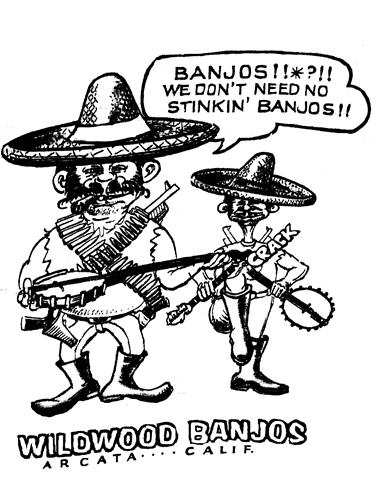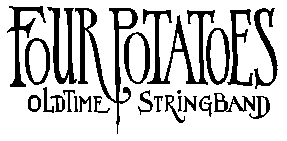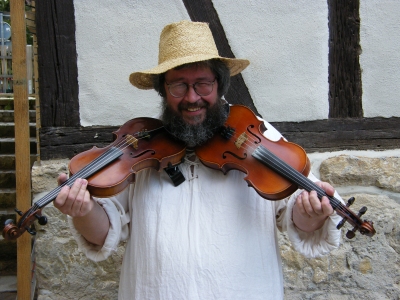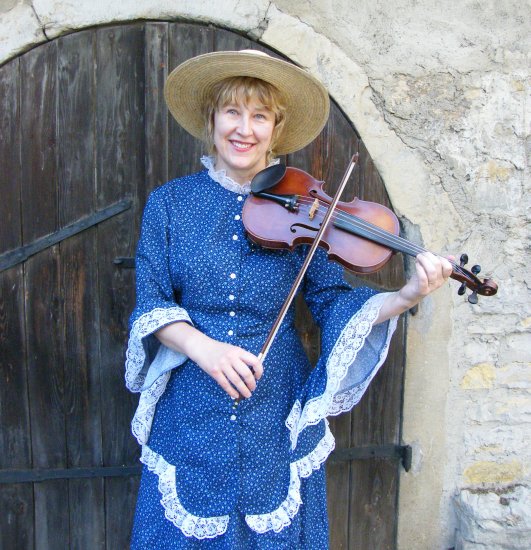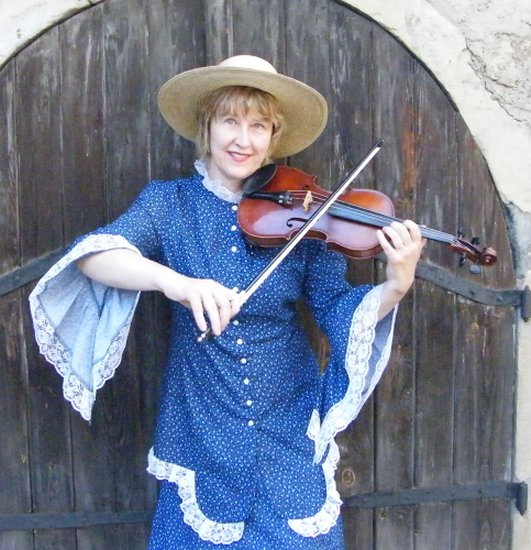The Instruments
BANJO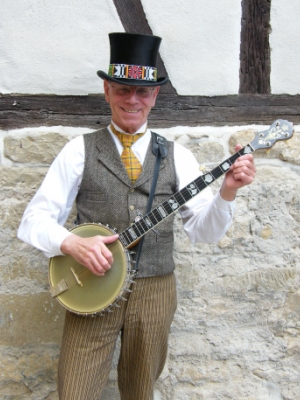 The banjo is a plucked string instrument. The sound board is like a drum skin stretched on a round wooden frame. The stretch of the skin can be adjusted by clamping bolts. It is said that banjo builders in the old days preferred cat skins. That is probably why most cats (amongst many others) don’t like the sound of the banjo. The banjo has a long fretted neck and it has 4, 5 or 6 strings. The 5th string (also called chanterelle) on the 5 string banjo does not run the full length of the neck; its tuner is situated at the 5th fret.
The banjo originates from an Afro-American instrument that was called “ban jar”. The oldest known reference is from the year 1678.
The tenor banjo is used in jazz music to make rhythm by playing the chords. In Irish music it is used as a melody instrument whereas in bluegrass the five string banjo is played mainly “Scruggs style”. This way of playing was created by the famous Earl Scruggs. Metal or plastic finger picks are put on the thumb, the index and middle finger of the right hand and thus pick single strings to create this special “Scruggs sound”. In “Old Time Music” the banjo style used is called clawhammer or frailing. It is played without the use of finger picks, the strings are plucked by the thumb and the nail of the index or middle finger.
Bluegrass banjos differ normally from old time banjos by having a so called resonator. This part of the banjo casts the sound that is produced inside the body towards the listeners, by that increasing the volume. The resonator is fixed at the back site of the body of the banjo. Old time banjos have an open back. They sound a little fainter or maybe one should say less shrill.
The tuners, in the old days wooden pegs, are today machines with worm gear. Another renewal (introduced in the 1940’s) is the tone ring. This is a metal ring (mostly bronze) that lies on the wooden frame of the body over which the skin is stretched. The effect of the tone ring on the sound is very strong. Famous international banjo players are the already mentioned Earl Scruggs, the folk musician Pete Seeger, Béla Fleck who modernized the "Scruggs style", in Irish music Barney McKenna of The Dubliners, Bob Schmidt of Flogging Molly and Gerry O’Connor who lives in Tipperary. In Germany Rüdiger Helbig made the banjo popular. One of the top German "Scruggs style" banjo players at present is Jürgen Biller.
The banjo is a plucked string instrument. The sound board is like a drum skin stretched on a round wooden frame. The stretch of the skin can be adjusted by clamping bolts. It is said that banjo builders in the old days preferred cat skins. That is probably why most cats (amongst many others) don’t like the sound of the banjo. The banjo has a long fretted neck and it has 4, 5 or 6 strings. The 5th string (also called chanterelle) on the 5 string banjo does not run the full length of the neck; its tuner is situated at the 5th fret.
The banjo originates from an Afro-American instrument that was called “ban jar”. The oldest known reference is from the year 1678.
The tenor banjo is used in jazz music to make rhythm by playing the chords. In Irish music it is used as a melody instrument whereas in bluegrass the five string banjo is played mainly “Scruggs style”. This way of playing was created by the famous Earl Scruggs. Metal or plastic finger picks are put on the thumb, the index and middle finger of the right hand and thus pick single strings to create this special “Scruggs sound”. In “Old Time Music” the banjo style used is called clawhammer or frailing. It is played without the use of finger picks, the strings are plucked by the thumb and the nail of the index or middle finger.
Bluegrass banjos differ normally from old time banjos by having a so called resonator. This part of the banjo casts the sound that is produced inside the body towards the listeners, by that increasing the volume. The resonator is fixed at the back site of the body of the banjo. Old time banjos have an open back. They sound a little fainter or maybe one should say less shrill.
The tuners, in the old days wooden pegs, are today machines with worm gear. Another renewal (introduced in the 1940’s) is the tone ring. This is a metal ring (mostly bronze) that lies on the wooden frame of the body over which the skin is stretched. The effect of the tone ring on the sound is very strong. Famous international banjo players are the already mentioned Earl Scruggs, the folk musician Pete Seeger, Béla Fleck who modernized the "Scruggs style", in Irish music Barney McKenna of The Dubliners, Bob Schmidt of Flogging Molly and Gerry O’Connor who lives in Tipperary. In Germany Rüdiger Helbig made the banjo popular. One of the top German "Scruggs style" banjo players at present is Jürgen Biller.
|
||||||
|
DOBRO 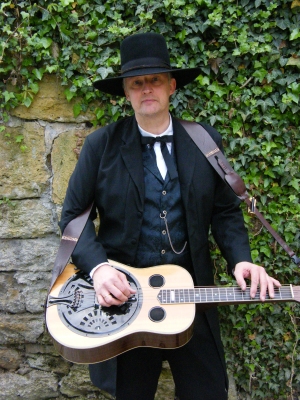 Dobro is the brand of a manufacturer of resonator guitars. The name comes from 5 Czechoslovak immigrants - the Dopyera Brothers – who started a guitar manufacturing company in 1927. Two years later John, Rudy und Ed Dopyera founded their own company that they named “Dobro”. As Dobro also means “good” in many Slavic languages, it is a very nice play upon words.
The trademark Dobro is owned now by the guitar manufacturer Gibson.
The resonator on a guitar originally had the purpose to increase the volume when electronic amplifiers did not yet exist. It is a metal part on the top of the guitar body looking very much like a hubcap. It makes the very special sound of this instrument.
Today the word Dobro is mostly the synonym for resonator guitars that are played as a slide or steel guitar. One way to play is to use a piece of glass or brass tube that the player puts on a finger of his left hand to slide it over the strings. In bluegrass music the Dobro is played lying on the players lap with the strings upwards. Instead of the tube a “steel bar” held in the left hand is used to play the strings. This way of playing is also called Hawaiian style. A man called Joseph Kekuku from Waikiki is acknowledged as the inventor of the Hawaiian steel guitar. As the story goes, as a schoolboy in the 1880’s he was playing comb and tissue paper while resting his guitar on his lap. The comb slipped, struck the guitar strings and the rest is a history of slides and whines. The instrument was given a higher action (distance between the fret board and the strings) and a square neck to give it a more stable position when lying on your lap. This style is also used to play the pedal steel guitar.
Dobro is the brand of a manufacturer of resonator guitars. The name comes from 5 Czechoslovak immigrants - the Dopyera Brothers – who started a guitar manufacturing company in 1927. Two years later John, Rudy und Ed Dopyera founded their own company that they named “Dobro”. As Dobro also means “good” in many Slavic languages, it is a very nice play upon words.
The trademark Dobro is owned now by the guitar manufacturer Gibson.
The resonator on a guitar originally had the purpose to increase the volume when electronic amplifiers did not yet exist. It is a metal part on the top of the guitar body looking very much like a hubcap. It makes the very special sound of this instrument.
Today the word Dobro is mostly the synonym for resonator guitars that are played as a slide or steel guitar. One way to play is to use a piece of glass or brass tube that the player puts on a finger of his left hand to slide it over the strings. In bluegrass music the Dobro is played lying on the players lap with the strings upwards. Instead of the tube a “steel bar” held in the left hand is used to play the strings. This way of playing is also called Hawaiian style. A man called Joseph Kekuku from Waikiki is acknowledged as the inventor of the Hawaiian steel guitar. As the story goes, as a schoolboy in the 1880’s he was playing comb and tissue paper while resting his guitar on his lap. The comb slipped, struck the guitar strings and the rest is a history of slides and whines. The instrument was given a higher action (distance between the fret board and the strings) and a square neck to give it a more stable position when lying on your lap. This style is also used to play the pedal steel guitar.
Martin has a few square neck resonator guitars, amongst others a Scheerhorn and an original Dobro by the Dopyera Brothers, a model F30 from 1936. |
||||||
|
FIDDLE
In many kinds of folk music the fiddle plays an important role, especially in Irish and Scottish folk music. But also music styles like bluegrass, country, cajun or even jazz are unthinkable without the fiddle. Although every violin can be played as a fiddle, some forms have come out unknown in classic music and are therefore limited to fiddling. E.g. some American fiddlers have the bridge sometimes shaved down so that it is less curved. This makes it easier to play double stops and triple stops, allowing one to play chords with less effort. In addition, many fiddle players prefer to use a tailpiece with fine tuners on all four strings instead of only using one on the E string as many classical players do. Many of the old time fiddlers use other tunings e.g. A-E-A-E to be able to play certain tunes more easily. In the old days, the fiddlers learned to play without learning to read notes. It was passed from grandfather, uncle or neighbor to the next generation by showing how it was done without straining theory. The word violin comes from Italian. The Guarneri and the Stradivari from Cremona, Italy, were the most famous violin makers. Ewe prefers to play a violin that comes from the flea market. He repairs it and then decides whether it is a Stradivari for him or not.
|
||||||
|
MANDOLIN 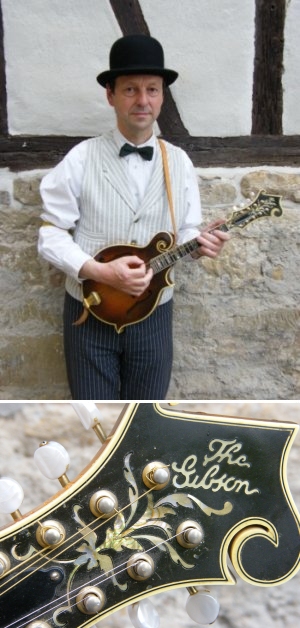 Mandolins evolved from the lute family in Italy during the seventeenth and eighteenth centuries. The deep bowled mandolin, produced particularly in Naples, became common in the nineteenth century. The original instrument was the mandore, which evolved in the fourteenth century from the lute. Over time and as the instrument spread around Europe, it took on many names and various structural characteristics. It is tuned like the violin and it has 4 double strings. The strings are played with a pick, different from a lute that is played with the fingers. Classic mandolins have the shape of an almond, which is what gave the instrument its name. In the USA, Orville Gibson started in 1890 to manufacture flat mandolins, designed like violins or German mandolins. He made two versions: the A-type mandolin with a symmetrical shape and an oval sound hole and the F-type mandolin with a scroll on one and a cutaway on the other side and f-holes (sound holes). By the year 1910 these mandolins were prevailed more and more over the classical shape. They were being played in mandolin orchestras, ragtime bands and vaudeville shows.
Mandolins evolved from the lute family in Italy during the seventeenth and eighteenth centuries. The deep bowled mandolin, produced particularly in Naples, became common in the nineteenth century. The original instrument was the mandore, which evolved in the fourteenth century from the lute. Over time and as the instrument spread around Europe, it took on many names and various structural characteristics. It is tuned like the violin and it has 4 double strings. The strings are played with a pick, different from a lute that is played with the fingers. Classic mandolins have the shape of an almond, which is what gave the instrument its name. In the USA, Orville Gibson started in 1890 to manufacture flat mandolins, designed like violins or German mandolins. He made two versions: the A-type mandolin with a symmetrical shape and an oval sound hole and the F-type mandolin with a scroll on one and a cutaway on the other side and f-holes (sound holes). By the year 1910 these mandolins were prevailed more and more over the classical shape. They were being played in mandolin orchestras, ragtime bands and vaudeville shows.
Wolfgang plays a Gibson F5 mandolin from 1980 manufactured by Gibson, Kalamazoo, Michigan. |
||||||
|
GITARRE 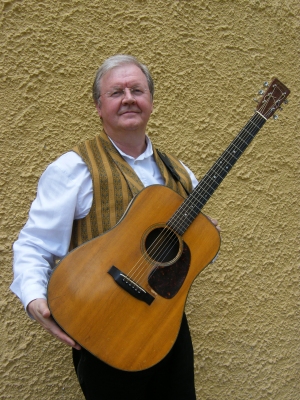 The guitar is a plucked string instrument, usually played with fingers or a pick. The guitar consists of a body with a rigid neck to which the strings, generally six in number, are attached. Guitars are traditionally constructed of various woods and strung with animal gut or, more recently, with either nylon or steel strings. Some modern guitars are made of polycarbonate materials. Guitars are made and repaired by luthiers. There are two primary families of guitars: acoustic and electric. Acoustic guitars (and similar instruments) with hollow bodies have been in use for over a thousand years. There are three main types of modern acoustic guitar: the classical guitar (nylon-string guitar), the steel-string acoustic guitar, and the arch top guitar. The tone of an acoustic guitar is produced by the vibration of the strings, which is amplified by the body of the guitar, which acts as a resonating chamber. The classical guitar is often played as a solo instrument using a comprehensive finger picking technique. Electric guitars, introduced in the 1930s, rely on an amplifier that can electronically manipulate tone. Early amplified guitars employed a hollow body, but a solid body was found more suitable. Electric guitars have had a continuing profound influence on popular culture. Guitars are recognized as a primary instrument in genres such as blues, bluegrass, country, flamenco, jazz, jota, mariachi, metal, reggae, rock, soul, and many forms of pop.
The guitar is a plucked string instrument, usually played with fingers or a pick. The guitar consists of a body with a rigid neck to which the strings, generally six in number, are attached. Guitars are traditionally constructed of various woods and strung with animal gut or, more recently, with either nylon or steel strings. Some modern guitars are made of polycarbonate materials. Guitars are made and repaired by luthiers. There are two primary families of guitars: acoustic and electric. Acoustic guitars (and similar instruments) with hollow bodies have been in use for over a thousand years. There are three main types of modern acoustic guitar: the classical guitar (nylon-string guitar), the steel-string acoustic guitar, and the arch top guitar. The tone of an acoustic guitar is produced by the vibration of the strings, which is amplified by the body of the guitar, which acts as a resonating chamber. The classical guitar is often played as a solo instrument using a comprehensive finger picking technique. Electric guitars, introduced in the 1930s, rely on an amplifier that can electronically manipulate tone. Early amplified guitars employed a hollow body, but a solid body was found more suitable. Electric guitars have had a continuing profound influence on popular culture. Guitars are recognized as a primary instrument in genres such as blues, bluegrass, country, flamenco, jazz, jota, mariachi, metal, reggae, rock, soul, and many forms of pop.
Egbert plays a Martin guitar Model D21 from 1958. |
